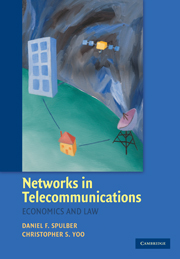Book contents
- Frontmatter
- Contents
- Preface
- Acknowledgments
- Introduction
- PART I THE ECONOMICS OF NETWORKS
- PART II THE REGULATION OF NETWORKS
- PART III POLICY APPLICATIONS
- 8 The Regulation of Local Telephone Networks
- 9 Antitrust as Applied to Network Industries
- 10 The Regulation of Last-Mile Broadband Networks
- 11 The Regulation of Broadband Networks and the Internet: Network Neutrality versus Network Diversity
- 12 The Regulation of Broadband Networks and the Internet: Network Neutrality versus Network Capacity
- Conclusion
- Bibliography
- Index
- Table of Cases
11 - The Regulation of Broadband Networks and the Internet: Network Neutrality versus Network Diversity
Published online by Cambridge University Press: 05 June 2012
- Frontmatter
- Contents
- Preface
- Acknowledgments
- Introduction
- PART I THE ECONOMICS OF NETWORKS
- PART II THE REGULATION OF NETWORKS
- PART III POLICY APPLICATIONS
- 8 The Regulation of Local Telephone Networks
- 9 Antitrust as Applied to Network Industries
- 10 The Regulation of Last-Mile Broadband Networks
- 11 The Regulation of Broadband Networks and the Internet: Network Neutrality versus Network Diversity
- 12 The Regulation of Broadband Networks and the Internet: Network Neutrality versus Network Capacity
- Conclusion
- Bibliography
- Index
- Table of Cases
Summary
Most Internet users communicate through a suite of nonproprietary protocols known as the transmission control protocol/Internet protocol (“TCP/IP”). Widespread adoption of TCP/IP has given the Internet a nearly universal interoperability that allows all end users to access Internet applications and content on a nondiscriminatory basis. Commentators, led by Lawrence Lessig (2002), have long been concerned that cable modem and DSL systems will use their control of the “last mile” of the network to block or slow access to content and applications that threaten their proprietary operations. The concern is that the resulting reduction in interoperability will produce a less favorable environment for competition and innovation in the market for Internet content and applications.
Some regulatory proposals attempt to preserve the transparency of the Internet by regulating last-mile providers' relationships with end users. Other proposals seek to regulate last-mile providers' relationships with network and content providers. Some call for mandating interconnection of broadband networks along standardized interfaces such as TCP/IP. Others argue in favor of a presumption that any discriminatory access agreements are anticompetitive, leaving the precise regulatory requirements to be developed over time through case-by-case adjudication. Although these proposals vary considerably in both their terminology and details, they can comfortably be aggregated within the broad rubric of “network neutrality.”
The term “network neutrality” is something of a misnomer. Adoption of any standardized interface has the inevitable effect of favoring certain applications and disfavoring others. For example, TCP/IP routes packets anonymously on a “first come, first served” and “best efforts” basis.
- Type
- Chapter
- Information
- Networks in TelecommunicationsEconomics and Law, pp. 373 - 404Publisher: Cambridge University PressPrint publication year: 2009



